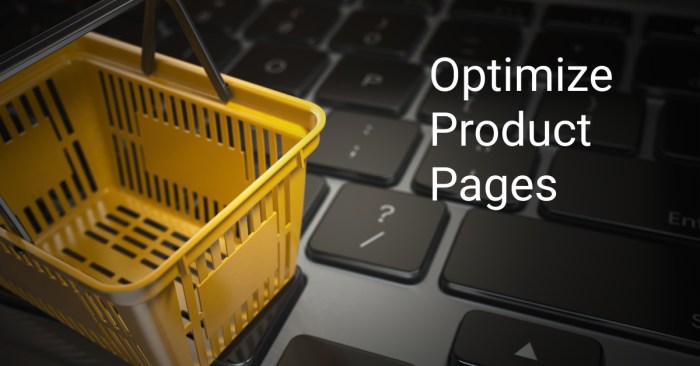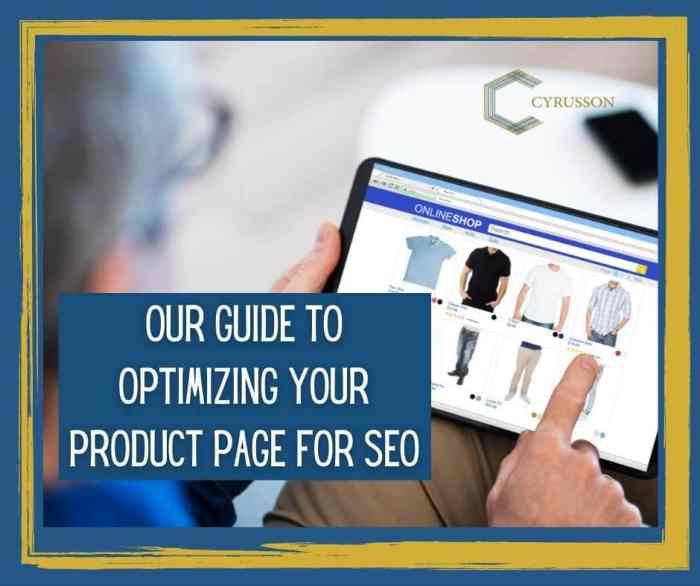Optimizing Product Pages is key to driving online sales to new heights. Dive into this essential guide packed with tips and strategies to create irresistible product pages that hook customers from the get-go.
From crafting compelling product descriptions to enhancing user experience, this comprehensive overview covers everything you need to know about optimizing product pages for maximum impact.
Introduction to Optimizing Product Pages

Optimizing product pages in e-commerce refers to the process of improving various elements of a product page to enhance its visibility, user experience, and conversion rates. This includes optimizing product titles, descriptions, images, pricing, and other key features to attract and engage potential customers.
Having well-optimized product pages is crucial for online businesses as it directly impacts their sales and overall success. By ensuring that product pages are easy to find, informative, and visually appealing, businesses can increase their chances of converting visitors into customers and ultimately driving revenue.
Examples of Successful Companies
- Amazon: With its detailed product descriptions, customer reviews, and user-friendly interface, Amazon has effectively optimized its product pages to provide a seamless shopping experience for customers.
- Apple: Apple’s product pages are known for their sleek design, high-quality images, and concise yet compelling product descriptions, creating a sense of exclusivity and desirability among consumers.
- Sephora: Sephora’s product pages feature interactive elements, such as swatches and tutorials, to help customers make informed purchasing decisions, resulting in higher engagement and conversion rates.
Elements of a Highly Optimized Product Page
When it comes to creating a highly optimized product page, there are several key elements that should be included to attract customers and influence their decision-making process.
Product Images
Product images play a crucial role in capturing the attention of potential customers. High-quality images that showcase the product from different angles can help customers visualize the product better and make an informed decision. Including multiple images, zoom features, and even product videos can enhance the overall shopping experience.
Product Descriptions
A detailed and informative product description is essential for providing customers with important details about the product. This includes specifications, features, dimensions, materials used, and any other relevant information. A well-written description can help customers understand the product better and address any potential concerns they may have.
Customer Reviews
Customer reviews are a powerful tool in influencing customer behavior. Positive reviews can build trust and credibility, while negative reviews can provide valuable feedback for improvement. Including a section for customer reviews on the product page can help potential customers make a more informed decision based on the experiences of others.
Pricing and Promotions
Clear pricing information and any ongoing promotions or discounts should be prominently displayed on the product page. Customers are more likely to make a purchase when they have a clear understanding of the pricing structure and any potential savings they can benefit from. Including pricing details can help customers evaluate the value proposition of the product.
Organizing and Presenting Information, Optimizing Product Pages
When organizing and presenting information on a product page, it’s important to consider the layout and design. Utilizing clear headings, bullet points, and concise descriptions can make it easier for customers to navigate the page and find the information they are looking for. Additionally, using visual cues such as icons or banners to highlight key features or promotions can draw attention to important details.
Best Practices for Product Page Optimization: Optimizing Product Pages

To ensure your product pages are optimized for maximum performance and user engagement, it’s essential to follow best practices that focus on improving load times, search engine visibility, and multimedia content utilization.
Improving Product Page Load Times
- Compress images and multimedia files to reduce file sizes without compromising quality.
- Utilize browser caching and enable Gzip compression to speed up loading times.
- Minimize HTTP requests and eliminate unnecessary plugins or scripts that can slow down the page.
Optimizing Product Descriptions for Search Engines
- Include relevant s naturally throughout the product description to improve search engine visibility.
- Use meta tags, alt text for images, and structured data markup to provide search engines with valuable information about your products.
- Write descriptive, unique, and engaging product descriptions that are easy to read for both search engines and users.
Role of Multimedia Content in Boosting Engagement
- Incorporate high-quality product images, videos, and interactive content to enhance user experience and showcase product features.
- Create video tutorials or demos to provide a more interactive and engaging way for users to learn about your products.
- Implement 360-degree views, zoom-in features, and product galleries to give users a comprehensive look at your products.
User Experience and Conversion Rate Optimization
User experience (UX) design plays a crucial role in influencing the conversion rates on product pages. A seamless and intuitive navigation flow can significantly impact how visitors interact with the page and ultimately lead to higher conversion rates. Implementing A/B testing methods can help in optimizing product pages and improving conversion rates.
Creating a Seamless Navigation Flow
When designing product pages, it is essential to create a seamless navigation flow that guides visitors through the page effortlessly. A clutter-free layout, clear call-to-action buttons, and intuitive menu structures can enhance the overall user experience and encourage visitors to explore more products.
- Ensure easy access to product information by organizing content logically.
- Use visual cues such as arrows or progress indicators to guide visitors through the buying process.
- Implement a search bar with autocomplete functionality for quick product searches.
- Optimize page loading speed to reduce bounce rates and improve user experience.
A/B Testing for Optimization
A/B testing involves comparing two versions of a webpage to determine which one performs better in terms of conversions. By testing different elements such as headlines, images, or call-to-action buttons, you can identify the most effective design for maximizing conversion rates.
- Start with testing one element at a time to isolate the impact of each change.
- Set clear goals and metrics to measure the success of each test.
- Continuously iterate and optimize based on the results of A/B tests to improve conversion rates over time.
- Utilize tools like Google Optimize or Optimizely to streamline the A/B testing process.